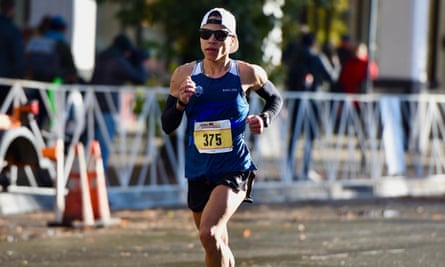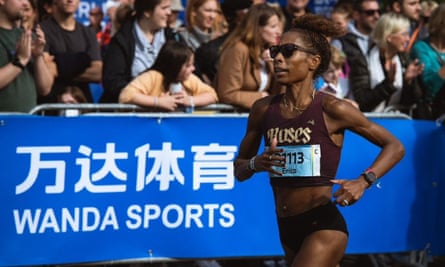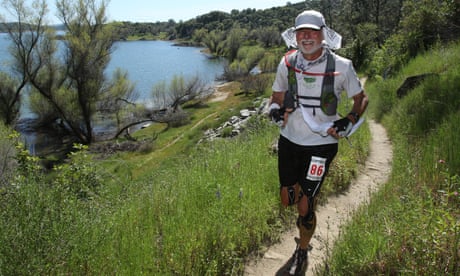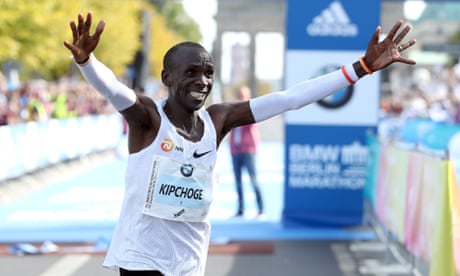March 2, 2023 The following article by Allison Torres Burtka appeared in The Guardian International today.
Gary Corbitt's project gets its due on an international level. Congratulations, Gary.
George Brose
Only 28 US-born Black women have broken three hours in the marathon. Why?
A file known as ‘The List’ has inspired long-distance runners to join a club that has relatively few members
At the California International Marathon in December 2022, more than 270 women finished in under three hours. Among them was Ariane Hendrix-Roach. She completed the race in a time of 2hr 35min 39sec, making her the second-fastest US-born Black female marathoner of all time – and qualifying her for the 2024 Olympic trials.
Throughout the history of marathon running, the number of Black women born in the US who have ever broken three hours adds up to 28. Sub-three-hour marathoners in the US include many white, Kenyan-born, and Ethiopian-born women – but not many US-born Black women. Why?
First, a sub-three-hour marathon is hard. It requires running at a pace of 6:50 minutes per mile – for 26.2 miles. Another reason may be lack of representation. “I think it’s been a lack of seeing ourselves in distance running,” Hendrix-Roach says. “Sometimes that can make people not want to be a part of something.”
Running historian Gary Corbitt has been tracking the American-born Black women who have broken three hours. Now it’s known simply as “The List,” and it’s beginning to get more attention in the running community. Corbitt recently revised it to add a few more runners.
The List began with a question from marathoner Shawanna White. She had read about Marilyn Bevans, the first African American female marathoner and the first to break three hours, which she did in 1975. White had broken three hours herself and wondered how many other American-born Black women had, as well as how many had qualified for the Olympic trials.
Her question made its way to Corbitt and Tony Reed, co-founder and executive director of the National Black Marathoners Association. “I, quite frankly, thought it would be impossible to try to find something like that out,” Reed says. “But Gary did his research and started compiling this list of women. So I really take my hat off to Gary.”
In 2018, 10 women were on The List. Corbitt continues to update it, and in five years, 18 more women have been added. Corbitt follows women he knows are close to breaking three hours, and now that The List has gotten some attention, people in the running community alert him when someone new breaks the barrier. Corbitt acknowledges that some women may have been overlooked – he recently added someone who broke three hours in 2016, after her friend emailed him.
White ran track and cross-country in high school and college, but she remembers getting steered toward sprints. “I went home, and I was telling my parents that I was going to be running the 800 and the 1600 [meters]. And their first response was that the coach is crazy. ‘This coach doesn’t know what he’s doing. You should be running 100, the 200,’” she says.
Coaches and parents may steer Black kids, “or maybe the children themselves just want to do the sprints because it’s shorter and that seems cool, and distance running is not portrayed as a cool sport. But I think that’s slowly changing,” White says.
White has run sub-three 16 times – more than any other woman on The List.
One of The List’s recent additions is Erica Stanley-Dottin, who ran a 2:52:05 at the Berlin Marathon in September 2022. Corbitt says she had been on his radar because she had come close to three hours repeatedly.
Among Black women, Stanley-Dottin says: “Honestly, distance running is not seen as our sport.” Another challenge may be that many women lack the money and time needed to travel to races, she adds.
Stanley-Dottin was a sprinter as a child, and she ran the 400m for Georgetown University. After college, she felt burned out and fell away from running competitively, although she kept it up as a hobby to stay active. “Marathoning certainly wasn’t something I thought I would ever get into,” she says. But she always watched the New York City Marathon, because it runs through her neighborhood. In 2007, she cheered on a friend who ran it. She had watched him train, and when she saw him on race day, “I was totally inspired.”
So she signed up to run a marathon the next year. “I downloaded a little plan off the internet in 2008, just kind of trained myself and went into it like: I’m gonna break four hours,” she says. “I ended up running a 4:06, and I was so pissed. So then I was like, ‘Well, I gotta do that again.’” But the next year, she got married and later had two kids, and she put marathoning on hold.

Nine years later, Stanley-Dottin was ready to get back out there, and she went after the same goal: This time, she ended up running a 3:56. “I was kind of hooked after that,” she says.
She decided she wanted a coach and a group to run with. “But I was very particular and very clear that I wanted to run with people who look like me, and I wanted a coach who looked like me, because I’ve always had that,” she says, so she joined the Black Roses NYC, which has a sizable number of Black members, in 2018. She learned about The List from her coach, Knox Robinson, and met Marilyn Bevans.
At the time, Stanley-Dottin didn’t think she could ever break three hours. But in conversations with her teammates – Black and white – that goal kept coming up. Over the next couple of years, the group got faster, and she and a couple of teammates saw that sub-three was within reach. When she ran sub-three last September, she was 48.
Stanley-Dottin is also NYC community manager for Tracksmith, a running apparel company. She says she hasn’t really felt unwelcome in the running community, but “where it’s most stark is in races, when you get to a certain point time-wise,” she says. Now, standing in her corral, “you’re surrounded by men, mostly white men.”
White agrees. “When you go to a starting line, you can pick us all out,” she says. “I want to be to a point where we just all blend in and it’s not like, ‘Oh, there goes the one single Black person’ or ‘There go the four Black people.’”
Stanley-Dottin, White, and Hendrix-Roach took different paths to become the sub-three marathoners they are today. But they share the excitement that The List is highlighting Black women’s achievements, as well as the sense that interest in marathoning is growing among Black women.
“I think now that we see more women and more media and attention on African American women in distance running, women can see themselves and say, ‘Hey, I want to do that, I want to meet them, or I want to do what they’re doing,’” Hendrix-Roach says. “I think that’s why we’ve seen more women are getting put on The List and are shooting for those times.”
Stanley-Dottin says The List has brought the women on it together. “The List itself is like a collective now,” she says. “We all kind of are connected and seek each other out and talk on social media, stuff like that. And then when we see each other, it’s like, so much love … We’re kind of building our own community within the community.”
Hendrix-Roach agrees. “For me as a runner, I check a lot of boxes – I’m African American, I’m gay, and for me to be on that list and be so supported by the other women on that list is something that I hold near and dear to my heart,” she says. “I’ve met Sika Henry and Shawanna White, and every time I see them, there’s so much camaraderie there and support.”
Reed wrote and directed the documentary Breaking Three Hours: Trailblazing African American Women Marathoners, which profiles nine of the women on The List. “One of the most interesting moments during the making of the documentary was where the women had dinner for the first time together” in 2021, Reed says. “I really wish that I had been recording the dinner, because just the support that they were giving each other, the admiration – they had heard about each other, but they’d never had an opportunity to meet.”
The documentary shows that “people did not want to acknowledge the accomplishments of the African American female runners,” Reed says.
“In general, our sport has done a poor job at preserving its history, and with African American running history, it’s even more so an issue,” Corbitt says. He has been working to preserve the legacy of his father, Ted Corbitt, who was the first Black American to run the marathon at the Olympics, as well as distance running more broadly.
“This is an effort to properly document the history of our sport,” Corbitt says. He also developed a team of researchers and storytellers to document the stories of women distance runners for an oral history project called Starting Line 1928. “Starling Line 1928 is the first time African American females have been interviewed in this type of manner, a systematic kind of way,” he says.

With The List, Corbitt was initially including Black women who were naturalized US citizens as well, but because it’s a larger group, he couldn’t devote the time to it. “That’s something that will, in time, be done,” he says.
The first time Hendrix-Roach heard about The List was when Corbitt told her she was on it. She first broke three hours in 2018.
Hendrix-Roach was not a runner growing up – she played basketball in high school and college. But as a kid, “my dad always thought that I was going to be this track star,” she recalls. “I have all of these memories of us going out in front of our house, and he would time me on his watch, running on our street to the stop sign, just as fast as I could.”
When Hendrix-Roach was a senior in college, she lost her dad to suicide. When she was in grad school and done playing basketball, she decided to run a marathon to honor him. She had never run a race before. She remembers thinking, “‘He always said I was going to be a runner, so I’m gonna do this, and it’ll be something for him.’ And it just kind of it stuck. I did one marathon and I’ve been a runner ever since.”
Hendrix-Roach finished that marathon in 3:57. In her second, she qualified for the Boston Marathon, and then she got serious. She broke three hours and then set her sights on the Olympic trials.
Hendrix-Roach says recent changes in the running community may be making distance running more attractive to underrepresented groups. Those changes include the variety of running groups and meetups, as well as brands shifting so that “it’s not all about being the fastest runner.” Social media influencers include a broader range of people – in ethnicity, look, and running speed, she says. “That really can help people say, ‘OK, I want to be a part of this. I see myself doing that and I can relate to them.’”
At one point, Hendrix-Roach says, “I worked for high-profile brand, and I just didn’t see myself represented in the brand – in the marketing, who we were gearing things towards … And I could no longer be a part of something that I didn’t see myself in.” So she left.
Hendrix-Roach recently accepted a position with Hoka as a wear test analyst. Now, she is looking forward to the Olympic trials, and she wants to become the fastest woman on The List.
White got into marathoning after she ran four races in one weekend. “After doing that, I was like, you know what, I guess I’ll go ahead and give the marathon a try,” she says. Some of her friends said she could break three hours, so she made that her goal. She didn’t make it the first time, but she’s done it 16 times since then.
The main barrier White sees to more American-born Black women running marathons is lack of exposure to distance running. “If you’re not seeing it at home, maybe you have a coach or a PE teacher that exposes you to distance running,” she says. As a PE teacher, she says, “I’m always talking about running with my kids.”
Reed had his five-year-old daughter in mind when making the documentary. “It’s important for her to have role models who look like her,” he says. About the women on The List, he says, “I really want them to serve as role models for up-and-coming distance runners.”
White says she sees growing interest in high school cross-country. “When I go to the local races around here in Columbia, South Carolina, I’m seeing more Black girls running distance,” she says.
In April, Stanley-Dottin will run her third Boston Marathon. Now 49, she says, “I am aware of my own – not to sound morbid, but my running mortality, so to speak. How many more miles and marathons do I have in me? So now I just want to see how fast I can go, how far can I take this. Running sub-three kind of set me up to be able to think that way.”
Breaking three is not where Stanley-Dottin is stopping. “How fast can I go – is it sub 2:50? Is it 2:45? I don’t know,” she says. “I don’t know how many more I have, but I’m gonna keep getting back out there and training and seeing what I got.”






No comments:
Post a Comment